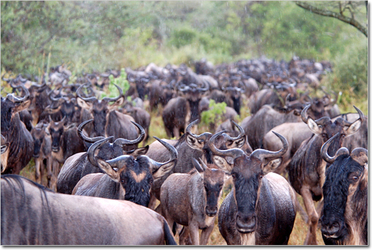African Savanna- Serengeti Plains
Productivity

Most savannas have a gross primary productivity of 3000kcal/squared meter/year. Sam McNaughton's experiments have estimated that there is a 66% Net Primary Productivity Rate in the Serengeti. This is so high compared to most regions because the majority of the animals are in the second trophic level. Most of them are large herbivores so a lot of the nutrients are transferred to these animals. The Serengeti has especially high productivity as a savanna because of the sheer number of animals that migrate through the area every year.
Since Lions are at the top of the food chain, with hyenas rarely eating them, there are essentially only 3 trophic levels, which means that the productivity rate is relatively high. The rate of primary production is positively correlated with the amount of rainfall, but grazing can also increase primary production. Grazing overall increases the growth rate of many grass species in a method called compensatory growth. Due to this compensatory growth, there are overall lower rates of respiration due to lower plant biomass, reduced self-shading, and improved water balance.
Since Lions are at the top of the food chain, with hyenas rarely eating them, there are essentially only 3 trophic levels, which means that the productivity rate is relatively high. The rate of primary production is positively correlated with the amount of rainfall, but grazing can also increase primary production. Grazing overall increases the growth rate of many grass species in a method called compensatory growth. Due to this compensatory growth, there are overall lower rates of respiration due to lower plant biomass, reduced self-shading, and improved water balance.
